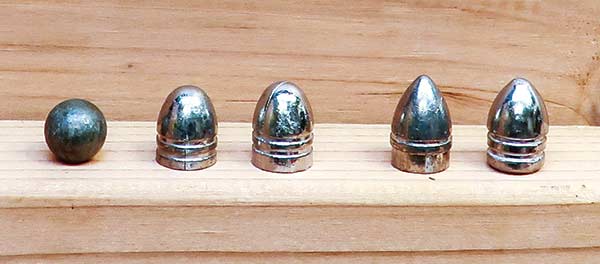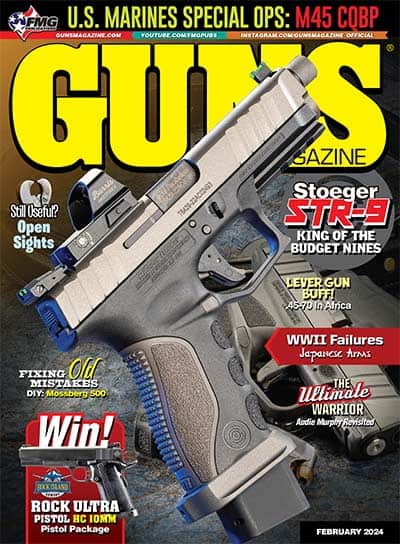Black Powder Conical Bullet With Other .44s
Old Doesn’t Mean Weak
During the Civil War, the South was hard-pressed to produce revolvers. JH Dance and his two brothers and two sisters lived on 900 acres outside of Columbia, Texas. One of the things their factory produced was cotton gins. The brothers fully intended to enlist in the Confederate Army; however, they were told they could be of much more use by turning their factory into the production of revolvers. So JH, his brothers and all his employees were exempt from military service and instead, put to work producing revolvers.
Dance Magic
The Dance & Brothers revolver was like all the rest based on the Colt pattern. It has the loading lever of the Colt 1851 Navy and a round barrel of the 1860 Army Colt. The major change is found in the frame. There is no recoil shield. Dance found they could use thinner forged steel to make a frame if they didn’t need the extra width necessary to reproduce the Colt recoil shield. If the percussion caps fit the nipples properly, the recoil shield is not necessary, plus this open space allows easy insertion of the caps.
The first production was in .36 caliber; however, they soon switched to .44 with about a total of 500 being produced. Today’s replica from Pietta is found only in .44 and is available with either a full-blued frame or blued/case hardened finish. For whatever the reason, I find the Dance sixgun balances better for me than the Colt.
I replaced the front sight on both Dance revolvers with Remington front sights set in the dovetail. Milt Morrison did the work for me. I also replaced the low-quality factory nipples with the high-quality vented stainless steel nipples from SliXprings. I also de-fanged the face of the hammer, smoothing off the face with a stone, and used a small file to remove any sharp edges around the safety. This safety on the hammer fits over a pin on the back of the cylinder, allowing the sixgun to be carried safely with six rounds. However, if allowed to remain sharp, it can pull fired caps off the nipple and cause a cap jam.
With these modifications, I did everything to make the Dance sixgun totally reliable. Almost! It worked very well, almost flawlessly with round ball loads — the trouble started when I switch to conical bullets. My two loads are 22.0 grains of H777 under the Johnston and Dow 217-grain authentic design bullet from Eras Gone molds. The muzzle velocity is 686 fps while dropping down to 20.0 grains only lowers the muzzle velocity by 6 fps and grouping in 1 1/2″ at 20 yards at point of aim. With the Eras Gone British Kerr bullet, I use 26 grains of H7774 at 760 fps and a tight group at point of aim. However, switching to Pyrodex using the same charge drops the muzzle velocity to 628 fps and opens the groups considerably. For my use, I find the Triple Seven load to be the best.
Conical Loads
Using conical bullets proved not to be practical in these two Dance sixguns without performing more modifications. The problem was not the load or the bullet but something I had not thought of until I started shooting them. For a percussion sixgun to be reliable, the mainspring has to be strong enough to hold the face of the hammer on the fired cap. If not, it can pull the cap off the nipple and cause a cap jam.
This proved to be what was happening. Not only did I get cap jams, but the fouling on the curve of the hammer where it meets the frame, built up very fast. Again this is the fault of the mainspring. So the simple answer is, if I want to shoot conical bullets on a regular basis in my Dance & Brothers revolvers, it will be necessary to beef up the mainspring.
Rogers & Spencer
What may be the best sixgun to come out of the Civil War era did not come from the South but actually came from Utica, N.Y. This revolver was the Rogers & Spencer. Depending on the resource, these sixguns either saw very limited use toward the end of the war or were not used at all. They were purchased as surplus by Bannerman and stored in a warehouse for decades.
The following quote is from Denis Adler in his book Black Powder Revolvers — Reproductions & Replicas (2008): “The large-frame revolvers resembled Remingtons, but were considerably different in execution, based on the Freeman revolver engineered by Austin T. Freeman who had been an employee of the Starr Armory in New York. The Freeman Revolvers in .44 caliber were originally produced by C.B. Hoard in Watertown, N.Y., but became a product of Utica Firearms manufactured by Rogers & Spencer late in 1864. The R&S model combined the Freeman design with that of a Remington, and the double action Pettengill revolver, which Rogers and Spencer had previously produced. The guns also resembled the Whitney revolver with the overall design of the Rogers & Spencer combining the front frame of a Remington with the back frame of a Starr, Starr-type loading lever and Pettengill backstrap and stocks.”
Too Late
An order of 5,000 .44 Rogers & Spencer sixguns was placed in January 1865. The war ended in May 1865 but the original order was not completed until four months later. As mentioned, they were in storage until 1904 when they were finally offered for sale. This is an exceptionally strong revolver design. Today I know of no one producing replicas of the Rogers & Spencer — my example is from Euroarms several years back. Unlike most replicas with bead front sights, the Rogers & Spencer has one which is tall enough to actually be used.
In my Rogers & Spencer, I use 30.0 grains of H777 under the Eras Gone Johnston & Dow for 743 fps. It shoots to point of aim at 20 yards and would certainly suffice for most uses. However, just as with the Dance sixgun, I need to beef up the mainspring to increase reliability. I have developed an especially powerful load using the Eras Gone Johnston & Dow bullet in the Rogers & Spencer at 950 fps but I choose not to publish it! However, note it is more powerful than the factory-offered standard .45 ACP and .45 Colt loads. Not bad for a design more than 150 years old!
Both the Dance & Brothers and the Rogers & Spencer can be loaded without removing the cylinder as the loading port unmodified is large enough to accept conical bullets. For the Dance sixgun, this is only true of the Kerr bullet. The Rogers & Spencer will accept the Johnston & Dow, Kerr, Lee Precision 200RN and the commercial-cast Kaido bullet. This makes the Rogers & Spencer especially desirable.







